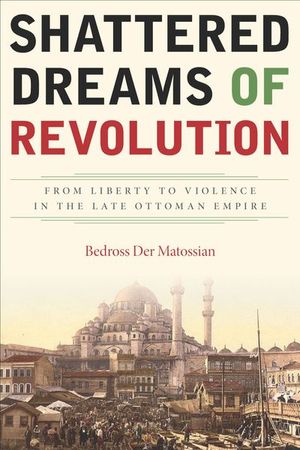Shattered Dreams of Revolution
Published by Stanford University Press
A study of the 1908 Young Turk Revolution from the perspectives of Arabs, Armenians, and Jews.
The Ottoman revolution of 1908 is a study in contradictions—a positive manifestation of modernity intended to reinstate constitutional rule, yet ultimately a negative event that shook the fundamental structures of the empire, opening up ethnic, religious, and political conflicts. Shattered Dreams of Revolution considers this revolutionary event to tell the stories of three important groups: Arabs, Armenians, and Jews. The revolution raised these groups’ expectations for new opportunities of inclusion and citizenship. But as post-revolutionary festivities ended, these euphoric feelings soon turned to pessimism and a dramatic rise in ethnic tensions.
The undoing of the revolutionary dreams could be found in the very foundations of the revolution itself. Inherent ambiguities and contradictions in the revolution’s goals and the reluctance of both the authors of the revolution and the empire’s ethnic groups to come to a compromise regarding the new political framework of the empire ultimately proved untenable. The revolutionaries had never been wholeheartedly committed to constitutionalism, thus constitutionalism failed to create a new understanding of Ottoman citizenship, grant equal rights to all citizens, and bring them under one roof in a legislative assembly. Today as the Middle East experiences another set of revolutions, these early lessons of the Ottoman Empire, of unfulfilled expectations and ensuing discontent, still provide important insights into the contradictions of hope and disillusion seemingly inherent in revolution.
Praise for Shattered Dreams of Revolution
“The sad fate of revolutions, from moments of euphoria and hope through the descent into authoritarianism, has seldom been told as persuasively as in this unique book. Bedross Der Matossian offers the stories of three peoples—Armenians, Arabs, and Jews—who greeted the 1908 Young Turk revolution with joy and optimism, only to find their expectations of liberation and modernity quickly turn into disillusion and brutal bloodletting.” —Ronald Grigor Suny, The University of Michigan
“Bedross Der Matossian explains with new historical evidence why and how the Young Turk revolution ultimately failed to attract Armenians, Jews, and Arabs to its cause. He makes a genuine contribution to our understanding of ethno-religious conflict and nationalism, suggesting interesting parallels with the failings of today’s Middle East revolutions.” —Philip S. Khoury, Massachusetts Institute of Technology
“A masterly account of the Young Turk Revolution . . . . Few scholars have devised such a stimulating and a multivocal framework for understanding the post-1908 realities that shaped the last Ottoman decade” —Eyal Ginio, The Hebrew University of Jerusalem
The Ottoman revolution of 1908 is a study in contradictions—a positive manifestation of modernity intended to reinstate constitutional rule, yet ultimately a negative event that shook the fundamental structures of the empire, opening up ethnic, religious, and political conflicts. Shattered Dreams of Revolution considers this revolutionary event to tell the stories of three important groups: Arabs, Armenians, and Jews. The revolution raised these groups’ expectations for new opportunities of inclusion and citizenship. But as post-revolutionary festivities ended, these euphoric feelings soon turned to pessimism and a dramatic rise in ethnic tensions.
The undoing of the revolutionary dreams could be found in the very foundations of the revolution itself. Inherent ambiguities and contradictions in the revolution’s goals and the reluctance of both the authors of the revolution and the empire’s ethnic groups to come to a compromise regarding the new political framework of the empire ultimately proved untenable. The revolutionaries had never been wholeheartedly committed to constitutionalism, thus constitutionalism failed to create a new understanding of Ottoman citizenship, grant equal rights to all citizens, and bring them under one roof in a legislative assembly. Today as the Middle East experiences another set of revolutions, these early lessons of the Ottoman Empire, of unfulfilled expectations and ensuing discontent, still provide important insights into the contradictions of hope and disillusion seemingly inherent in revolution.
Praise for Shattered Dreams of Revolution
“The sad fate of revolutions, from moments of euphoria and hope through the descent into authoritarianism, has seldom been told as persuasively as in this unique book. Bedross Der Matossian offers the stories of three peoples—Armenians, Arabs, and Jews—who greeted the 1908 Young Turk revolution with joy and optimism, only to find their expectations of liberation and modernity quickly turn into disillusion and brutal bloodletting.” —Ronald Grigor Suny, The University of Michigan
“Bedross Der Matossian explains with new historical evidence why and how the Young Turk revolution ultimately failed to attract Armenians, Jews, and Arabs to its cause. He makes a genuine contribution to our understanding of ethno-religious conflict and nationalism, suggesting interesting parallels with the failings of today’s Middle East revolutions.” —Philip S. Khoury, Massachusetts Institute of Technology
“A masterly account of the Young Turk Revolution . . . . Few scholars have devised such a stimulating and a multivocal framework for understanding the post-1908 realities that shaped the last Ottoman decade” —Eyal Ginio, The Hebrew University of Jerusalem
BUY NOW FROM
COMMUNITY REVIEWS

